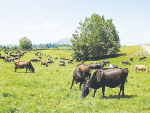Last year a survey was done on soil stability and disturbance in Waikato using aerial photographs taken in 2012. Here's what was found.
Of all sample points, 51.3% were stable land surfaces, 22.6% were erosion-prone but inactive and 18.8% had signs of recent (but re-vegetating) or fresh erosion. The remaining 7.3% of the sample points were extensively disturbed, where soil had been removed in whole or part, due to either the presence of rural buildings and yards, urban areas or water bodies.
Under the National Policy Statement for Freshwater Management and subsequent plan change, there is a need to protect our streams, rivers, creeks, drains, lakes, dams and wetlands from degradation and contamination by managing their banks (riparian margins).
Winter weather strains the banks of farm waterways, increasing the risk of erosion. So it’s timely to look at the issues involved in erosion, and land management practices that can contribute to contamination of waterways.
Some of our rivers, lakes and streams have eroding banks, silted beds, water weed infestation and degraded water quality, often the result of sub-optimal land management.
Stock wading in water, poor effluent treatment, overgrazing, inappropriate fertiliser application, pugging and poor run-off control on cultivated land, roads and tracks can all contribute to the contamination of waterbodies.
Pathogens like giardia and cryptosporidium can cause water-borne diseases, which in turn can cause serious health problems, while nitrates and phosphates can also create health disorders for people and stock, and contribute to algal growth.
Having an appropriate buffer around waterways can reduce these effects by stabilising the banks and providing a filter for contaminants washing off the land. Effective management of the banks – or riparian strips – is a key to protecting aquatic life and improving water quality, generally.
The mix of species to be planted within riparian areas should be carefully selected to beneficially modify what’s happening with light, temperature, nutrient and sediment loads, channel and bank stability, carbon inputs, and habitat for terrestrial species.
Shrubs and trees with extensive root systems, which tolerate moist soil conditions and frequent silt deposits, are ideal for stream bank erosion control. They physically hold the stream banks together and some tree roots also protect the stream bed, limiting the scouring effect of running water.
Streamside vegetation provides shade which cools the water, improves dissolved oxygen levels, helps aquatic life and reduces the risk of algal blooms.
Suitable plant species beside waterways also provide cover for spawning fish, and food and habitat for nesting and juvenile birds. Streamside trees can link areas of native vegetation together, extending habitat for native birds.
Besides environmental benefits, riparian planting can also help a farm’s economy.
Well-designed riparian fencing can help with mustering, and protect animals from drowning or getting stuck in wet areas. The provision of shelter and shade is recognised as an important aspect of animal production and health.
Improved milk grades are documented where dairy sheds no longer draw water from contaminated streams. On sheep and beef properties, stock are in better health and have faster weight gain when water sources are no longer contaminated.
The council’s catchment management officers are available to advise on soil conservation, riparian management and other good land management practices.
• Bala Tikkisetty is a sustainable agriculture advisor at Waikato Regional Council.


















